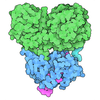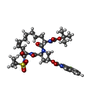Entry Database : PDB / ID : 3m5lTitle Crystal structure of HCV NS3/4A protease in complex with ITMN-191 NS3/4A Keywords / / / / / / / / / Function / homology Function Domain/homology Component
/ / / / / / / / / / / / / / / / / / / / / / / / / / / / / / / / / / / / / / / / / / / / / / / / / / / / / / / / / / / / / / / / / / / / / / / / / / / / / / / / / / / / / / / / / / / / / / / / / / / / / / / / / / Biological species Method / / / / Resolution : 1.25 Å Authors Schiffer, C.A. / Romano, K.P. Journal : Proc.Natl.Acad.Sci.USA / Year : 2010Title : Drug resistance against HCV NS3/4A inhibitors is defined by the balance of substrate recognition versus inhibitor binding.Authors : Romano, K.P. / Ali, A. / Royer, W.E. / Schiffer, C.A. History Deposition Mar 12, 2010 Deposition site / Processing site Revision 1.0 Nov 24, 2010 Provider / Type Revision 1.1 Jul 13, 2011 Group Revision 1.2 Aug 9, 2017 Group / Source and taxonomy / Category / softwareRevision 1.3 Feb 21, 2024 Group Data collection / Database references ... Data collection / Database references / Derived calculations / Structure summary Category chem_comp / chem_comp_atom ... chem_comp / chem_comp_atom / chem_comp_bond / database_2 / entity / pdbx_entity_nonpoly / pdbx_struct_conn_angle / struct_conn / struct_ref_seq_dif / struct_site Item _chem_comp.name / _database_2.pdbx_DOI ... _chem_comp.name / _database_2.pdbx_DOI / _database_2.pdbx_database_accession / _entity.pdbx_description / _pdbx_entity_nonpoly.name / _pdbx_struct_conn_angle.ptnr1_auth_comp_id / _pdbx_struct_conn_angle.ptnr1_auth_seq_id / _pdbx_struct_conn_angle.ptnr1_label_atom_id / _pdbx_struct_conn_angle.ptnr1_label_comp_id / _pdbx_struct_conn_angle.ptnr1_label_seq_id / _pdbx_struct_conn_angle.ptnr3_auth_comp_id / _pdbx_struct_conn_angle.ptnr3_auth_seq_id / _pdbx_struct_conn_angle.ptnr3_label_atom_id / _pdbx_struct_conn_angle.ptnr3_label_comp_id / _pdbx_struct_conn_angle.ptnr3_label_seq_id / _pdbx_struct_conn_angle.value / _struct_conn.pdbx_dist_value / _struct_conn.ptnr1_auth_comp_id / _struct_conn.ptnr1_auth_seq_id / _struct_conn.ptnr1_label_asym_id / _struct_conn.ptnr1_label_atom_id / _struct_conn.ptnr1_label_comp_id / _struct_conn.ptnr1_label_seq_id / _struct_conn.ptnr2_auth_comp_id / _struct_conn.ptnr2_auth_seq_id / _struct_conn.ptnr2_label_asym_id / _struct_conn.ptnr2_label_atom_id / _struct_conn.ptnr2_label_comp_id / _struct_conn.ptnr2_label_seq_id / _struct_ref_seq_dif.details / _struct_site.pdbx_auth_asym_id / _struct_site.pdbx_auth_comp_id / _struct_site.pdbx_auth_seq_id
Show all Show less Remark 999 The cofactor 4A residues 990-1000(GLY SER VAL VAL ILE VAL GLY ARG ILE ASN LEU) in this entry ... The cofactor 4A residues 990-1000(GLY SER VAL VAL ILE VAL GLY ARG ILE ASN LEU) in this entry correspond to residues numbering 1678-1688 of database sequence reference (UNP A8DG50). This peptide is covalently linked to the N-terminus of NS3. C1679S mutation was engineered to prevent disulfide formation. The V1686I and I1687N were engineered to optimize the linker between the cofactor 4A and NS3.
 Yorodumi
Yorodumi Open data
Open data Basic information
Basic information Components
Components Keywords
Keywords Function and homology information
Function and homology information Hepatitis C virus subtype 1a
Hepatitis C virus subtype 1a X-RAY DIFFRACTION /
X-RAY DIFFRACTION /  SYNCHROTRON /
SYNCHROTRON /  MOLECULAR REPLACEMENT /
MOLECULAR REPLACEMENT /  molecular replacement / Resolution: 1.25 Å
molecular replacement / Resolution: 1.25 Å  Authors
Authors Citation
Citation Journal: Proc.Natl.Acad.Sci.USA / Year: 2010
Journal: Proc.Natl.Acad.Sci.USA / Year: 2010 Structure visualization
Structure visualization Molmil
Molmil Jmol/JSmol
Jmol/JSmol Downloads & links
Downloads & links Download
Download 3m5l.cif.gz
3m5l.cif.gz PDBx/mmCIF format
PDBx/mmCIF format pdb3m5l.ent.gz
pdb3m5l.ent.gz PDB format
PDB format 3m5l.json.gz
3m5l.json.gz PDBx/mmJSON format
PDBx/mmJSON format Other downloads
Other downloads 3m5l_validation.pdf.gz
3m5l_validation.pdf.gz wwPDB validaton report
wwPDB validaton report 3m5l_full_validation.pdf.gz
3m5l_full_validation.pdf.gz 3m5l_validation.xml.gz
3m5l_validation.xml.gz 3m5l_validation.cif.gz
3m5l_validation.cif.gz https://data.pdbj.org/pub/pdb/validation_reports/m5/3m5l
https://data.pdbj.org/pub/pdb/validation_reports/m5/3m5l ftp://data.pdbj.org/pub/pdb/validation_reports/m5/3m5l
ftp://data.pdbj.org/pub/pdb/validation_reports/m5/3m5l Links
Links Assembly
Assembly
 Components
Components Hepatitis C virus subtype 1a / Strain: BID-V318 / Gene: NS3 / Plasmid: pET28a / Production host:
Hepatitis C virus subtype 1a / Strain: BID-V318 / Gene: NS3 / Plasmid: pET28a / Production host: 
 X-RAY DIFFRACTION / Number of used crystals: 1
X-RAY DIFFRACTION / Number of used crystals: 1  Sample preparation
Sample preparation SYNCHROTRON / Site:
SYNCHROTRON / Site:  APS
APS  / Beamline: 21-ID-F / Wavelength: 0.97872 Å
/ Beamline: 21-ID-F / Wavelength: 0.97872 Å molecular replacement
molecular replacement Processing
Processing MOLECULAR REPLACEMENT / Resolution: 1.25→42.35 Å / Cor.coef. Fo:Fc: 0.972 / Cor.coef. Fo:Fc free: 0.967 / Occupancy max: 1 / Occupancy min: 0.5 / SU B: 1.14 / SU ML: 0.023 / SU R Cruickshank DPI: 0.042 / Cross valid method: THROUGHOUT / ESU R: 0.042 / ESU R Free: 0.039 / Stereochemistry target values: MAXIMUM LIKELIHOOD / Details: HYDROGENS HAVE BEEN ADDED IN THE RIDING POSITIONS
MOLECULAR REPLACEMENT / Resolution: 1.25→42.35 Å / Cor.coef. Fo:Fc: 0.972 / Cor.coef. Fo:Fc free: 0.967 / Occupancy max: 1 / Occupancy min: 0.5 / SU B: 1.14 / SU ML: 0.023 / SU R Cruickshank DPI: 0.042 / Cross valid method: THROUGHOUT / ESU R: 0.042 / ESU R Free: 0.039 / Stereochemistry target values: MAXIMUM LIKELIHOOD / Details: HYDROGENS HAVE BEEN ADDED IN THE RIDING POSITIONS Movie
Movie Controller
Controller






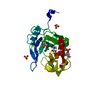
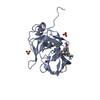
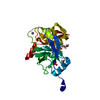
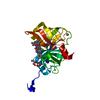



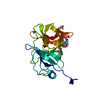

 PDBj
PDBj